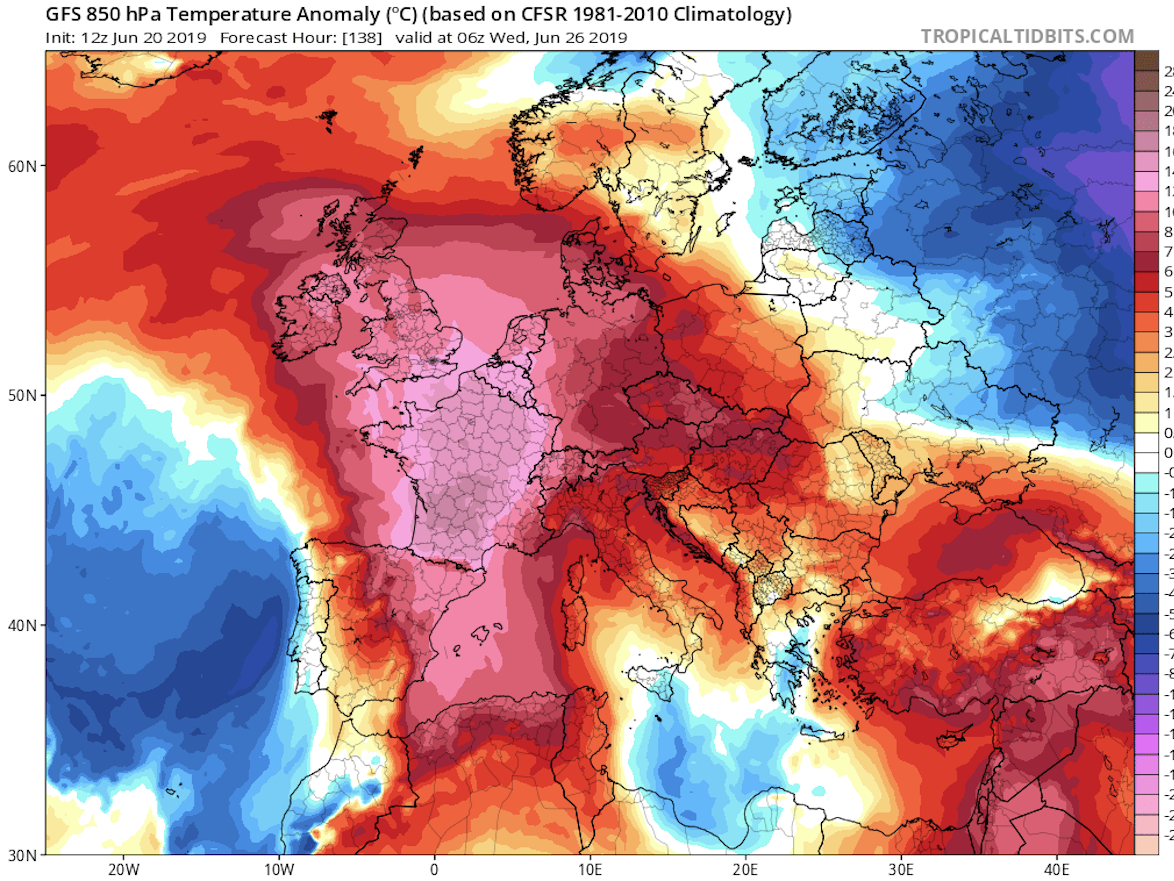
- Europe is experiencing a severe heat wave this week: Parts of France, Germany, the Czech Republic, and Spain have seen record-breaking temperatures.
- Today, in the French town of Capentras, temperatures hit 111.7 degrees Fahrenheit (44.3 degrees Celsius) – a new national temperature record.
- The cause of the heat wave is an abnormal high-pressure weather system sitting over Europe.
- Because of climate change, the world will see even more extreme heat waves if greenhouse-gas emissions aren’t cut significantly and quickly.
- Visit Business Insider’s homepage for more stories.
“Today is the hottest day in the history of France,” meteorologist Eric Holthaus tweeted.
The town of Carpentras, near Avignon on France’s southern coast, hit a blistering 111.7 degrees Fahrenheit (44.3 degrees Celsius) today.
This broke the country’s previous national temperature record of 111.4 degrees Fahrenheit (44.1 degrees Celsius), set in August 2003. Officials in Paris have put the city on high alert. Schools across the country have been shut down, and students’ exams have been postponed.
These blistering temperatures are part of a record-breaking heat wave baking Europe this week. Germany, Poland, and the Czech Republic have also experienced the highest temperatures ever recorded in the month of June. Temperatures hit 100.8 degrees Fahrenheit (38.2 degrees Celsius) in Radzyń, Poland, on Wednesday and 101.5 (38.6) in Berlin, according to AccuWeather.
At least three people have died as a result of the heat wave in France so far, according to the French newspaper Midi Libre. Authorities reported that these people died of shock after jumping into cold water to escape the heat.
In Paris, children (and their parents) are splashing in the Eiffel Tower's Trocadero fountain. In Germany, men are riding mopeds naked and streaking through the frozen aisle at the grocery store.
According to meteorologists, the cause of these record-breaking temperatures is an unprecedented high-pressure weather system in Europe's atmosphere.
"'El infierno,' or hell, is coming," the Spanish meteorologist Silvia Laplana tweeted Sunday.
Here's why this high-pressure weather system is causing such severe temperatures.
A vast zone of high-pressure air
An upper ridge, in weather terms, is a vast zone of high-pressure air that sits atop a geographic region, trapping warm air in place.
Mika Rantanen, a meteorologist in Finland, tweeted on Wednesday that "Europe is under a historically strong upper ridge."
To understand this upper ridge, imagine a continent-sized umbrella of high-pressure air. Right now, that umbrella has Europe under its brim, and it isn't moving. So warm winds blowing northward from the Mediterranean and North African Sahara are getting forced earthward by the high-pressure air and held in place.
Normally, this warm air would rise into the upper atmosphere to cool off before circulating back to the surface. But the air in a high-pressure system is dense, so it pushes less dense air down, preventing the usual mixing. Without that cycling, the air on the ground just gets hotter, leading temperatures to skyrocket. That's a heat wave.
"There's never been a high pressure system over Europe that matches the current one, in all the decades we've been keeping track," Holthaus tweeted Tuesday. "The atmosphere is different now."
Linking heat waves to climate change

Researchers haven't yet confirmed a link between this particular heat wave and global warming, though a 2016 report from the National Academy of Sciences linked extreme heat in general to climate change. This is because greenhouse gases that enter the atmosphere trap more heat on the planet, causing Earth's surface temperatures to rise.
One study found that climate change made the European heat wave of 2003 twice as likely, while a 2018 analysis reported that climate change has made heat waves similar to last year's European heat wave five times more likely. According to France's national weather agency, the number of heat waves in the country has doubled in the past 34 years and is expected to double again by 2050.

"Monthly heat records all over the globe occur five times as often today as they would in a stable climate," Stefan Rahmstorf of the Potsdam Institute for Climate Impact Research told The Associated Press. "This increase in heat extremes is just as predicted by climate science as a consequence of global warming caused by the increasing greenhouse gases from burning coal, oil and gas."
This trend is especially worrisome because intense heat can cause people to suffer heat exhaustion or heat stroke - when body temperatures rise to 106 degrees Fahrenheit (41.1 degrees Celsius) or higher within 10 to 15 minutes - which can damage the brain or other vital organs. Infants and children up to 4 years old and elderly people 65 and older are particularly at risk.
According to one study, extreme heat events are responsible for more deaths worldwide every year than hurricanes, lightning, tornadoes, floods, and earthquakes combined.
This isn't the first time Europe has experienced a severe heat wave
Europe is no stranger to heat waves. In July, the continent experienced a similar heat wave, with temperatures above 90 degrees Fahrenheit (32.2 degrees Celsius) as far north as the Arctic Circle.
France's previous national temperature was set sixteen years ago, on August 12, 2003, when 15,000 people across the country died in a severe summer heat wave.

All told, more than 70,000 people total perished across Europe that summer, during one of the deadliest heat waves in history.

